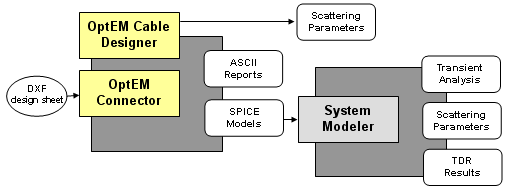OptEM: Cable System Tools - Software for Cable and Connector Modeling
Cable System Tools
Cable System Tools
OptEM provides two separate software tools that can be used together for cable/connector system modeling and analysis, or independently for specific cable or connector design issues.

OptEM Cable Designeris a PC (Windows) software tool used for accurate modeling and analysis of high-performance multi-conductor flex, unshielded twisted-pair (UTP) and twisted-pair (TP) cables. The software uses a hierarchical-design modeling concept where users draw design elements that become building blocks in constructing higher level cable designs. Each design element has unique position, rotation and lay length properties which provide realistic twisting parameters. The changing cable geometry is extruded automatically using twisting, backtwisting, collapsing and enclosure shaping algorithms as required. OptEM Cable Designer's accuracy is ensured by the built-in electromagnetic field solver which analyzes high frequency skin and proximity effects in wires, eddy currents in shields, and dielectric losses in insulation. The results produced by the software include S-parameter output such as FEXT, NEXT, and RL; text reports (ASCII) with transmission parameters, attenuation, characteristic impedance and additional data; and SPICE transmission line models that may be used in subsequent cable/connector system modeling.
OptEM Connectoris a Sun or HP workstation (UNIX) software tool used for modeling high-speed data transmission connectors. The software reads DXF CAD files from which multiple cross-section regions are extracted and assigned to specific positions within the connector profile in order to facilitate 3D modeling. A frequency dependent electromagnetic field analysis is performed that includes high frequency skin and proximity effects in wires, eddy currents in shields, and dielectric losses in insulation. Results produced by the software include time domain reflectometry (TDR); S-parameter output; text reports (ASCII) with transmission parameters, attenuation, characteristic impedance and additional data; and SPICE transmission line models that may be used in subsequent cable/connector system modeling.